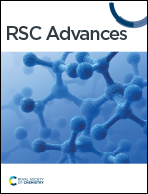Probing the separation mechanism of solid–liquid components in oily sludge and sludge containing polymers for a harmless treatment process of sludge
Abstract
In this study, the compositions of oily sludge and sludge containing polymers were analyzed. Sludge was separated preliminarily by conditioning centrifugal technology, whereby the temperature of the centrifugal process and the amount of oil/water separating agent were optimized. Thermal decomposition technology was combined in order to achieve the efficient treatment of sludge. The results showed that the compositions of oily sludge and sludge containing polymers were complex. Therefore, they could not meet the requirements of environmental protection only by conditioning centrifugal technology. After optimization, the best conditioning centrifugal temperature was 70 °C and the content of the oil/water separating agent was 2%. The high efficiency treatment of oily sludge and sludge containing polymers could be realized by combining conditioning centrifugal technology with the thermal decomposition technology. It is found that the sludge could meet the requirements of environmental protection after this combined treatment. This technology has strong adaptability to different types of oilfield sludge. This work is of great significance for the efficient treatment of oily sludge and sludge containing polymers and for environmental protection.



 Please wait while we load your content...
Please wait while we load your content...